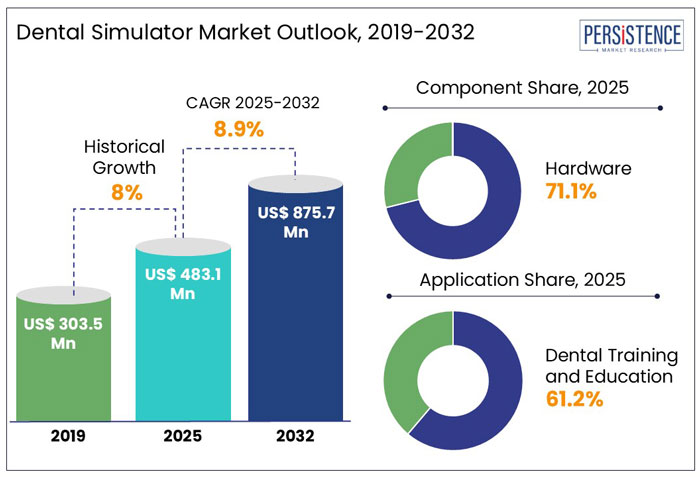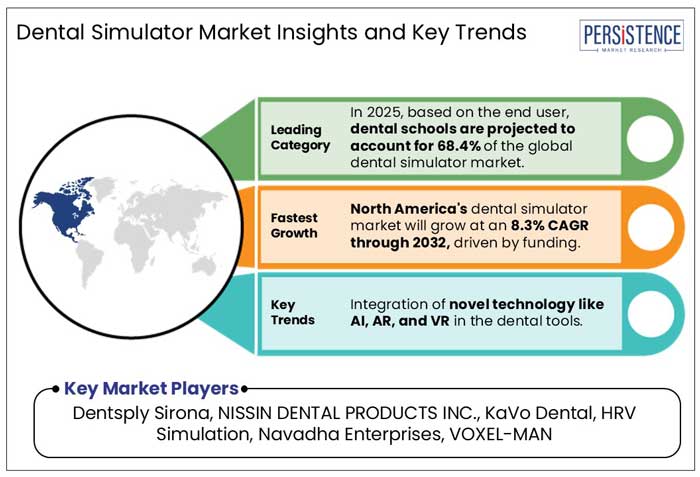Industry: Healthcare
Published Date: March-2025
Format: PPT*, PDF, EXCEL
Delivery Timelines: Contact Sales
Number of Pages: 182
Report ID: PMRREP35164
The global dental simulator market size is anticipated to rise from US$ 483.1 Mn in 2025 to US$ 875.7 Mn by 2032. It is projected to witness a CAGR of 8.9% from 2025 to 2032. The demand for dental simulators is rising due to the increasing number of dental practitioners and institutes worldwide.
As of 2023, there were over 2.5 million dentists globally, with the U.S. alone having approximately 202,000 licensed dentists, while densely populated regions such as India have over 300,000 registered dental professionals. The emphasis on hands-on training and skill development has led to a surge in dental institutions, with more than 1,500 dental schools globally.
Countries such as China, the U.S., and Germany are making investments in dental education technology, increasing demand for sophisticated simulators with haptic feedback, AI integration, and virtual reality to enhance preclinical training.

Key Highlights of the Dental Simulator Market
|
Global Market Attributes |
Key Insights |
|
Dental Simulator Market Size (2025E) |
US$ 483.1 Mn |
|
Market Value Forecast (2032F) |
US$ 875.7 Mn |
|
Projected Growth (CAGR 2025 to 2032) |
8.9% |
|
Historical Market Growth (CAGR 2019 to 2024) |
8.0% |
Dental Schools Worldwide Embrace Simulators for Skill Development Growth
As per Persistence Market Research, the global dental simulator industry witnessed a CAGR of 3.9% in the historical period between 2019 and 2024. The increasing demand for dental education has accelerated the use of simulation technologies in dental schools and training institutions.
With over 1,500 dental schools globally and an increasing number of dental students, the need for advanced preclinical training tools has intensified. In 2023, the American Dental Education Association (ADEA) reported a 5.3% rise in dental school enrollments in the U.S., while India added over 300 new dental colleges since 2019.
Simulation-based training, including haptic feedback systems, virtual reality, and AI-driven patient cases, has improved student confidence and clinical competency. The University of Pennsylvania School of Dental Medicine and King’s College London have integrated digital simulators to enhance preclinical experience, reducing errors in real-world procedures.
China and Japan are enhancing dental education through VR-based platforms, ensuring standardized, high-quality training for future practitioners, thereby enhancing patient care standards in the forthcoming years.
Trend of Aesthetic Dentistry Boost the Demand for Procedure-specific Simulators
In the estimated timeframe from 2025 to 2032, the global market for dental simulator is likely to showcase a CAGR of 6.7%. The demand for dental implants and cosmetic procedures fuels the need for advanced simulation-based training to enhance practitioner skills.
Over 12 million dental implant procedures were performed globally in 2023, with the U.S. and Europe leading due to aging populations and increasing awareness of aesthetic dentistry. Dental simulators, equipped with haptic feedback and virtual reality, allow practitioners to refine techniques in implant placement, bone grafting, and cosmetic restorations before treating real patients.
Companies like Nobel Biocare and Straumann are integrating digital workflow training modules into their implant systems. The demand for procedure-specific simulators in dental education and professional training programs is anticipated to increase as the global cosmetic dentistry industry develops through 2032.
Innovations in Dental Training Platforms Shows Avenues for Investment
The demand for advanced dental training platforms is surging, driven by technological innovations like haptic feedback, VR, and AI. Such advanced technologies enhance preclinical training by providing realistic simulations of dental procedures, allowing students and professionals to refine their skills before treating patients. Haptic-enabled simulators, such as the Simodont Dental Trainer, offer real-time tactile feedback, improving manual dexterity and precision.
The use of virtual reality training technologies in dentistry schools is growing. For instance, over 50 healthcare learning institutions throughout the globe employ Virteasy Dental and Moog Simodont, which give students practical experience. The need for ongoing training for more than 500,000 dental professionals globally is expected to drive considerable demand for dental simulation in the healthcare industry.
The integration of machine learning algorithms further personalizes training modules, adapting to individual skill levels. As the number of dental practitioners and institutes grows, simulation-based education will play a vital role in ensuring high-quality, patient-centered care.
Industry Grapples with the Scarcity of Skilled Professionals in Developing Nations
The high cost of advanced dental simulators, particularly those featuring haptic feedback, augmented reality, and virtual reality, poses significant challenges for the global dental simulator industry. These high-end models can range from US$50,000 to US$100,000 each, making them unaffordable for dental schools in low-income countries.
Along with financial burden, the shortage of qualified dental professionals in regions such as Asia Pacific, Latin America, and Africa, where the dentist-to-population ratio is often less than one dentist per 10,000 people, further limits the widespread adoption of such technologies.
Cost-sensitive institutions struggle to invest in these cutting-edge training resources, which hinders the overall growth of the simulator industry and slows the advancement of digital dentistry education worldwide.
Digital Imaging and AI Reshaping Dental Training Platforms
The global dental simulator industry is witnessing noteworthy growth, driven by advancements in AI-powered assessment, 3D printing, and digital dentistry workflows. AI-enhanced simulators play a pivotal role in improving student performance evaluation by offering real-time feedback on hand movements, pressure application, and procedural accuracy, thereby fostering skill development.
Institutions such as Columbia University and NYU College of Dentistry have embraced AI-driven assessment systems within their training programs, aiming to elevate the quality of preclinical education.
The advent of 3D printing technology is transforming dental training by enabling the creation of patient-specific models for authentic simulations, thereby reducing reliance on traditional cadaver use. Renowned institutions like Harvard School of Dental Medicine are utilizing 3D-printed anatomical models to support training in endodontics and implantology, which contributes to enhanced clinical preparedness for students.
Furthermore, the increasing adoption of digital dentistry workflows, including CAD/CAM technology and digital imaging, is stimulating demand for comprehensive simulation platforms.
Companies such as Dentsply Sirona and 3Shape are providing integrated solutions for scanning, designing, and milling restorations, ensuring that students and professionals are well-prepared to adapt to contemporary dental practices. These technological advancements are poised to influence the future of dental education and the integration of simulation methodologies.
High-Tech Improvement in Hardware Shows Avenues in Dental Simulation Industry
The hardware segment of the dental simulator market is projected to dominate with a 71.1% revenue share in 2025, driven by advancements in electrically connected care technologies and the widespread use of phantom heads, patient simulators, and stereoscopic display systems.
Institutions and training centers are investing in high-fidelity simulation workstations to improve student competency in dental procedures. Companies like Nissin Dental Products and KaVo Dental lead in manufacturing realistic training models that replicate patient conditions with precision.
The use of virtual training platforms and AI-driven assessment tools is driving the software segment's rapid growth. To enhance skill development, dental clinics, and institutions are using force feedback software and CAD/CAM.
Interactive haptic-enabled training systems with real-time evaluation and feedback are available from companies like Dentsply Sirona and Simodont. As digital dentistry develops, simulation software will keep growing and provide immersive, affordable training options that improve dental education learning outcomes.
Simulation-Based Dental Training and Education Paves the Way for Skill Development
On the basis of applications, the dental training and education segment is projected to dominate the global dental simulator market, holding a 61.2% share in 2025. This growth is fueled by the increasing number of dental graduates and the widespread adoption of simulation-based learning in dental schools worldwide.
The World Health Organization estimates that there are over 3.5 billion cases of oral diseases globally, driving the need for highly skilled dental professionals. Advanced simulation tools, such as VR and haptic feedback systems, enhance hands-on training, improving students’ confidence and clinical skills. Institutions like Harvard School of Dental Medicine and King’s College London have incorporated dental simulators to bridge the gap between theoretical learning and practical application.
On the other hand, the treatment planning segment is expected to hold a market share of 38.8%, driven by rising dental awareness and demand for aesthetic procedures. Digital smile design and AI-driven treatment simulation software allow practitioners to plan and visualize treatments before execution.

Research in Digital Medical Programs Presents Avenues in North America
The dental simulator market in North America is set to hold a 38.4% market share in 2025, driven by increased funding and the rising demand for digital dentistry training. The dental simulator industry in North America is expected to showcase a CAGR of 8.3% through 2032.
The U.S. and Canada lead innovation, with the Canada Digital Adoption Program (CDAP) allocating US$ 4 Bn to help small- and medium-sized enterprises integrate digital technologies, including dental simulation systems.
In the U.S., institutions like Harvard School of Dental Medicine and NYU College of Dentistry are incorporating AI-driven haptic feedback simulators and VR training units, enhancing student proficiency. The use of manikins and VR-based patient models in training facilities has surged, improving pre-clinical training efficiency and reducing dependency on live patients.
Innovation in 3D Printing and Bioprinting Offers Prospects in Europe
The dental simulator market in Europe is projected to hold a 28.6% market share in 2025, driven by innovations in 3D printing and bioprinting technologies. Countries like the U.K. and Germany are at the forefront of the digital transformation of the medical industry, with companies investing in additive manufacturing for dental simulation models and training tools.
The European Union’s Horizon 2020 program has funded multiple bioprinting research projects, supporting the growth of customized dental models for student training and patient-specific treatment planning. The German-based EOS GmbH and U.K.-based Renishaw Plc are pioneering metal and polymer 3D-printed dental components, enhancing simulation accuracy and realism.
Universities like Charité - Universitätsmedizin Berlin and King's College London have adopted digital dental processes, which has sped up market growth. With personalized, patient-specific training models that reduce dependency on cadavers, 3D printing is transforming dentistry education in Europe, providing high-precision learning experiences for future dental professionals.
Surge in Dental-care Initiatives in Asia Pacific Paves the Way for the Modernization
The dental simulator market in Asia Pacific is projected to grow, with the increasing adoption of digital dental education and advanced simulation tools.
Japan is anticipated to play a crucial role in 2025, supported by government-led oral health initiatives and smart dental innovations. The Japanese Dental Association reports that over 90% of citizens receive preventive dental care, increasing demand for high-tech training simulators.
In India, rapid dental education advancements are fueling market expansion, with institutions like Saveetha Dental College pioneering the use of Virteasy Dental simulators for realistic training. The Indian dental education sector is growing, with over 300 dental colleges, many integrating VR and haptic feedback technologies.
The use of AI-driven simulation systems by China's dental tool manufacturing sector is driving market expansion and raising demand for advanced dentistry training programs.
The global dental simulator market represents a dynamic sector within the healthcare industry, dedicated to providing innovative virtual training and simulation solutions specifically designed for dental practitioners. These advanced systems replicate real-world dental practice scenarios, enabling students and experienced professionals to acquire essential hands-on experience in a controlled and risk-free environment.
In this evolving sector, key players are employing a variety of growth strategies to enhance their offerings. This includes forging strategic partnerships and collaborations, pursuing acquisitions to expand their reach, and focusing on continuous product development to introduce cutting-edge technical solutions. Such efforts not only help strengthen their product portfolios but also create a competitive advantage in a rapidly advancing industry.
Key Industry Developments
|
Report Attributes |
Details |
|
Historical Data/Actuals |
2019 - 2024 |
|
Forecast Period |
2025 - 2032 |
|
Market Analysis Units |
Value: US$ Bn/Mn, Volume: As applicable |
|
Geographical Coverage |
|
|
Segmental Coverage |
|
|
Competitive Analysis |
|
|
Report Highlights |
|
|
Customization and Pricing |
Available upon request |
By Component
By Application
By End User
By Region
To know more about delivery timeline for this report Contact Sales

The market is set to reach US$ 25.15 Bn in 2025.
In 2025, dental practices must stay abreast of the rapid growth and potential of 3D printing technology in their dental applications.
Dentsply Sirona, NISSIN DENTAL PRODUCTS INC., KaVo Dental, HRV Simulation, and Navadha Enterprises are a few leading players.
The industry is estimated to rise at a CAGR of 6.7% through 2032.
North America is projected to hold the largest share of the industry in 2025.